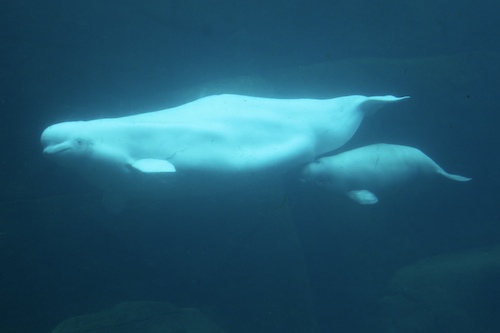By: Ainsley MacLeod
The beluga whale is seen in large numbers among the Arctic and Alaskan regions of our planet. The beluga whales inhabiting the St. Lawrence estuary, however, are not found in large numbers and are facing levels of toxicity that are not seen in other habitats of marine life. When it comes to the St. Lawrence Estuary, the beluga whale population is endangered. Since there are hundreds of animal species that are endangered and at risk of being gone and forgotten forever, if the complete population of the beluga whale is not an endangered species, why would anyone focus on the population of the beluga inhabiting the St. Lawrence Estuary of Québec?
Historically, this population of the beluga whale has been vulnerable to hunting and pollution. In 1979, Hunting of the beluga whale by non Indigenous groups became illegal. Up until then, the biggest danger to this beluga population was commercial hunting. Consequently, with a combination of hunting along with the rapid increase of pollution, the number of beluga whales in the St. Lawrence Estuary drastically dropped from 10,000 before 1885 to an estimated 900 just in 2012. Indicating that “commercial whaling has depleted the population severely.” It might seem as though the direct killing of this species is something that holds the primary responsibility for such rapid depletion of their population, however, since the hunting of “belugas has been banned since 1979” scientists have not found any “noticeable recovery in the population.”
The present population is not able to recover as it should even would have during the times that they were allowed to be hunted. For over 40 years no St. Lawrence beluga has been blatantly killed. With a stop to commercial hunting, they face another problem which is severely depleting and harming their numbers. Pollution is easily able to absorb into the waters that these mammals live in. As the St. Lawrence River functions as a convenient and immediate mode for industrial transportation, this local pollution specific to this area of Québec is harming these mammals at an alarming rate.
Above is a map of Canada’s ten aluminum smelters, revealing that Québec is home to nine of them. Each of Québec’s nine smelters appears to be within a close distance to the St Lawrence River, which is convenient for transporting goods to and from boats, but also indicates that the pollutants emitted from these smelters do not have a long way to go when it comes to reaching the St. Lawrence river. The belugas remain in the St. Lawrence Estuary all year round, meaning they do not migrate to waters that are less polluted and colder during the temperature shift between seasons like other cetacean species. Taking a break from these copious amounts of pollution is not an option.
Pollution accumulates through the diet of the beluga whale. Many contaminants are fat-soluble, this poses a threat to their diet as the belugas anatomical makeup consists of 40 to 50 percent lipids. Dr. Daniel Martineau is a veterinarian whose research specializes in the belugas of the St. Lawrence Estuary. He conducted a study from 1983 to 2012 looking at the rate of cancer in these animals. It is not until research and pathology are done on dead subjects that information on life-threatening issues will become acknowledged. Martineau’s study was conducted for over 25 years and with this research, he discovered the pollutants that are commonly found within the necropsies. Answering why the St. Lawrence beluga whale population has not been growing as it should and what pollutants are threatening and shortening their lives.

Fatty tissue plays an important part in the anatomical makeup of the beluga whale. These lipids lie just under their skin to provide insulation in the form of thermoregulation as the blubber under the beluga’s skin is also a convenient energy reserve. The pollutants are lipophilic contaminants that gather within the body fat of the belugas. As pollutants, such as PAH’s and PCP’S, accumulate within the belugas fatty tissue, it is dangerous for baby belugas to drink their own mother’s milk, as they are receiving a higher concentration of these contaminants. This is because the milk that the mother beluga will produce for her baby is 40 percent fat. Meaning, these babies ingest a higher absorption of pollution in their food than their mothers do before them.
From Dr. Martineau’s studies of pollution among the SLE beluga taking place “from 1983 to 2012” his research of cancer in these mammals “determined that 18-20 percent of the adult whales exhibited cancer.” It was within this time frame that “222 beluga whales” were used for Martineau’s lab to perform necropsies on them. These numbers are concerning as Martineau called the percentage of such a wide population of mammals dying of cancer “unusual,” and this is because “other similar studies of marine mammals revealed only 1 – 2 percent of adults dying of cancer.” This has to do with this population of marine life being so remotely close to “one of the most industrialized regions of the world, as regions within the “St. Lawrence River ecosystem” obtain “effluents from much of northeastern North America” along with the nine smelters condensed nearby the region of Québec close to the St. Lawrence River.
This species of the St. Lawrence Estuary Beluga is native to this area of Québec, Canada. They appear here naturally, and as this is their habitat and home, they must stay here to reclaim their population, allow for the water’s biodiversity to prosper and for the ecosystem of the St. Lawrence Estuary to be rescued. This population keeps on decreasing, and there have not been any signs of it growing back to its original numbers. Risking the population of the St. Lawrence Estuary Beluga whale indicates that Indigenous groups are at risk of losing another aspect of something culturally important to them. The health of the aquatic environment belugas live in will be compromised and thrown out of balance as they are primary consumers, other species will overcompensate and overpopulate for this loss. Not enough concern is transpiring for this species. Raising a concern enough to put a stop to this pollution comes with the reality that “constructing [the extent of] chemical impact, especially visually, is challenging. Toxins often do not look toxic.” It is difficult to determine the “physical consequences of exposure to toxins” so diseases “such as cancer, may not be visible and the contaminants can exist in the soil, water, or air for years, making it difficult to “capture the relationship between toxin and effect.”1
Toxicity and pollution are killers of our wildlife, and primary consumers like our St. Lawrence beluga whales are the first to experience loss in their numbers. The belugas of Alaska and the Arctic are allowed to flourish, their numbers steady because they are distant from such concentrated amounts of pollution and toxicity, an opportunity that is not available to the beluga whales of the St. Lawrence estuary. They are living their lives in pollution. To the people who have the power to stop this species from becoming extinct, to the people who care about each whale that has been lost, the ongoing production of aluminum smelters neighbouring the St. Lawrence Estuary either needs an alternative realm of production or they must come to an end, otherwise, our nation will watch these belugas disappear instead.
References
“Beluga: Why they Matter” World Wildlife Fund 1250 24th Street, N.W. Washington, DC 20037. 2021.
“Beluga Whale (St. Lawrence Estuary population)” Government of Canada, Fisheries and Oceans Canada, Communications Branch, Government of Canada, 25 July 2019.
Lair, S. Measures, L.N. Martineau, D. DFO. 2012. Recovery Strategy for the beluga whale (Delphinapterus leucas) St. Lawrence Estuary population in Canada. Species at Risk Act Recovery Strategy Series. Fisheries and Oceans Canada, Ottawa. 88 pp + X pp.
Martineau, Daniel D.M.V., M.Sc., Ph.D., Dipl. A.C.V.P. Beluga Whales of the St. Lawrence River: The “River Sweepers” Professor (retired), Department of Pathology and Microbiology, Faculty of Veterinary Medicine, Université de Montréal. Copyright PHIPPS Conservatory 2021. All rights reserved. Presented in 2018.
Martineau et.al. Pathologic Findings and Trends in Mortality in the Beluga (Delphinapterus leucas) Population of the St Lawrence Estuary, Québec, Canada, From 1983 to 2012 Veterinary Pathology 2016, Vol. 53(1) 22-36 a The Author(s) 2015 Reprints and permission: sagepub.com/journalsPermissions.nav DOI: 10.1177/0300985815604726 vet.sagepub.com
McKinney, Melissa. A et.al. Biotransformation of polybrominated diphenyl ethers and polychlorinated biphenyls in beluga whale Delphinapterus leucas) and rat mammalian model using an in vitro hepatic microsomal assay Aquatic Toxicology. Corresponding author at: National Wildlife Research Centre, Canadian Wildlife Service, Environment Canada, Ottawa, Ont., Canada K1A 0H3.© 2005 Elsevier B.V. All rights reserved. doi:10.1016/j.aquatox.2005.08.016
Mathes, Kera. How do Whales Nurse? Let’s Find Out! Aquarium of the Pacific. 2009.
Industry Overview ALU Québec: Aluminum cluster. Sitemap. 2021
Peeples, Jennifer. Imaging Toxins Environmental Communication Vol. 7, No. 2 (2013), 191-210.
